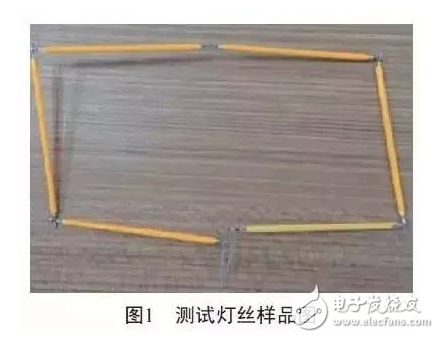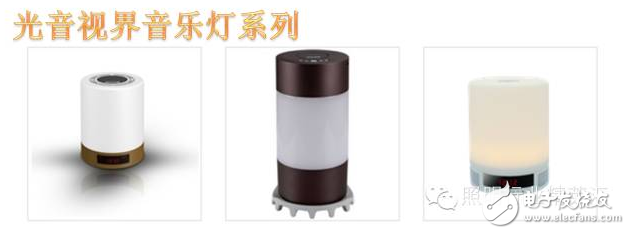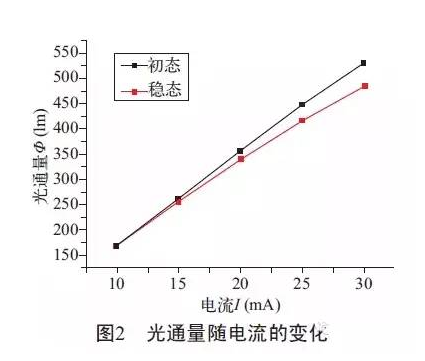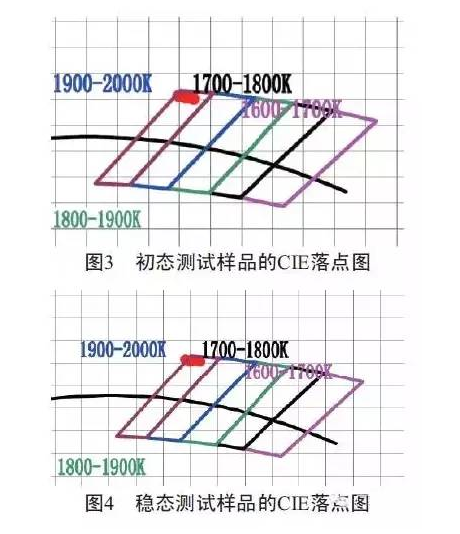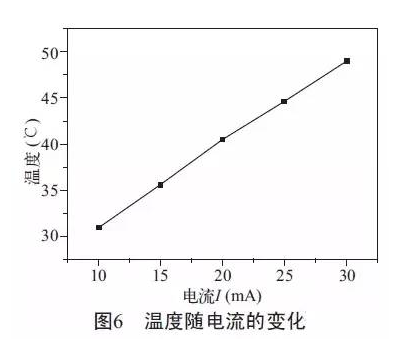Flip-chip LED filaments have become the focus of market research due to their flip-chip and planar coating processes and 360° stereo illumination. For a long time, experts at home and abroad have devoted themselves to the study of LED uniformity of illumination. However, LED is a comprehensive system in which light, electricity and heat interact with each other. The optical performance of the output is affected by the input current and junction temperature. When the minority carriers injected into the PN junction of the LED are combined with the majority carriers, the excess energy is released as light, and the electrical energy is directly converted into light energy, but in the process, a large amount of heat is generated. If the heat cannot be dissipated in time, the temperature of the PN junction will rise rapidly, which will affect the illuminating performance of the flip-chip LED filament. In this paper, the law of the output light and color temperature of the flip-chip LED filament driven by different DC currents with the input current and temperature is studied. The luminous flux and color temperature of the initial state and steady state (after lighting for 30 minutes) are compared. The effect of optical performance. 1. Sample preparation and testing 1.1 Sample preparation The flip-chip LED chip is fixed on a white ceramic substrate by a die bonder with a ceramic substrate size of 60 mm & TImes; 1.2 mm & TImes; 0.38 mm, chip size of 12 mil & TImes; 26 mil, and the filament is dispensed by a two-layer coating method. . Six filaments prepared by the above method were taken, and six filaments were connected in series, and the sample was as shown in FIG. 1.2 Testing The luminous flux, color temperature and color coordinates were measured using an integrating sphere of the model ZWL-9200. The LED to be tested is placed in the center of the integrating sphere by a fixed fixture. The light emitted by the LED passes through the white diffuse reflection layer inside the integrating sphere, and a part of the light is diffused and transmitted through the aperture aperture fiber on the surface of the integrating sphere to the micro multi-channel spectrometer. The data collected by the spectrometer passes. The USB interface is sent to the computer for processing and display, and the light source is powered by a constant current source. 2. Analysis and discussion The test was carried out using a Chinese integrating sphere. The sample is illuminated, placed in the integrating sphere, and tested for transient color temperature, luminous flux, and chromaticity coordinates. After lighting for 30 min, measurements were taken again to obtain steady-state optical performance. Subsequently, the transient and steady state data are analyzed and compared to arrive at a conclusion. 2.1 Luminous flux analysis The change of luminous flux with current is shown in Fig. 2. Whether in the initial state or steady state, the luminous flux increases with the increase of current. This is because the PN junction is the core part of the light-emitting diode. After the current is increased, the number of electrons and holes injected into the light-emitting region increases, and the amount of radiation recombination increases, resulting in an increase in the luminous flux of the LED. In theory, the luminous flux of an LED increases linearly with increasing current. However, as shown in Fig. 2, in the initial state and the current is 10~25 mA, the change of the luminous flux with the current is a straight line with a slope of K=18, and the current and the luminous flux are almost linear, and at 25~30. At mA, the slope K = 16.1313, with a significant drop. It can be seen that in the initial state, the current and the luminous flux are almost linear. When the LED is lit, the slope of the LED chip is saturated, and the slope is significantly reduced. In steady state, the slope between two adjacent points is K1=17.591 2, K2=16.557 8, K3=15.113 2, K4=13.668 4, the luminous flux is no longer linear with current, and with the increase of current The amount of increase in luminous flux is getting smaller and smaller (the slope is gradually decreasing). This is because the rise of the current causes the junction temperature to rise, and the filament does not dissipate in time, causing the junction temperature to affect the luminous flux and cause light decay. It can be seen that heat causes the chip to age, and chip aging is the root cause of the decrease in luminous flux. According to the comparison between the initial state and the steady state in Fig. 2, it can be found that after 30 minutes of lighting (ie, steady state), the luminous flux of the filament is decreased, and the decreasing trend is more and more obvious with the increase of the current. At 10 mA, the steady-state luminous flux is 99.8% of the transient. At 15 mA, the steady-state luminous flux is 98% of the transient. At 20 mA, the steady-state luminous flux is 95% of the transient, 25 mA. When driven, the steady-state luminous flux is 92.7% of the transient. At 30 mA, the steady-state luminous flux is 91% of the transient. It can be seen that when the input current is small, the phenomenon that the luminous flux decreases with increasing temperature is not clear, but as the current is gradually increased, the light decay phenomenon is very obvious. Since the electro-optical conversion efficiency of the LED decreases as the temperature rises, that is, the amount of visible light generated by inputting the same electric power is reduced, the luminous flux is also reduced. 2.2 Color temperature analysis According to Fig. 3 and Fig. 4, the color temperature at different currents of the initial state and the steady state are in the bin area, and the falling points are concentrated, which conforms to international standards. After entering the steady state, the color coordinates are still very concentrated, with no obvious drift. The main factor of the drift of the color coordinates is the aging of the phosphor performance, and the excessive heat is the primary factor leading to the aging of the phosphor. It can be seen that the flip-chip LED filament has good heat dissipation, thereby ensuring the stability and reliability of the flip-chip LED filament. The slight drift of the color coordinates is related to the particles of the phosphor, the uniformity of the stirring, the brightness of the chip, and the like. According to Figure 5, the color temperature of the flip-chip filament rises at steady state. At 10 mA, the increase is 0.39%. At 15 mA, the increase is 0.48%. At 20 mA, the increase is 0.68. %, at 25 mA, the increase is 0.77%, and at 30 mA, the increase is 0.77%. The increase of color temperature tends to be saturated with the increase of current, indicating that the thermal quenching effect of the phosphor is greater than that of the chip, and the temperature of the thermal radiation is greater than the temperature of the chip. The color temperature increases with the increase of current, because the blue light emitted by the chip in the flip-chip filament increases with the increase of the current, and the thickness of the phosphor layer is constant, and the blue component in the emitted white light increases, thereby making the filament The color temperature increases, and as the blue light emitted by the LED chip tends to be saturated, the increase in color temperature will also become slow. British physicist Kelvin discovered the relationship between light color and temperature in a physical experiment in 1848. He put the black body (also known as the absolute black body, also called the complete radiator) in a sealed container and heated it to the absolute zero (-273.16 °C) as the starting point. For every 1 °C increase in temperature, the color temperature is increased by 1K. Temperature and current are also linear. Therefore, the color temperature is also linear with current. However, according to Figure 5, the slope drops from about 4.5 to about 1.4, regardless of the initial state or steady state at 15 mA. It can be seen that the increase of current, the rise of temperature can not only stimulate the blue light of the LED chip, but also cause the attenuation of the LED chip, and the effect of temperature on the attenuation of the LED will be much greater than the blue light excited by it. 2.3 Temperature analysis The average temperature of the filament after 30 minutes of illumination was measured using a thermocouple. According to the formula Tj=Ths+RjPheat=Ths+RjKhPd, where Rj is the internal thermal resistance of the LED, Tj is the junction temperature, and Kh is the heating coefficient. It can be seen that the average temperature of the filament reflects the inside of the filament to some extent. Junction temperature. It can be seen from Fig. 6 that the temperature increases with the increase of the current, and the temperature and the current are almost linear, and the relationship is T=0.908I+22. This shows that the increase in current does not cause a sudden rise in temperature to burn out the filament, but the heat generated by the increase in current has a certain effect on the optical characteristics of the flip-chip LED filament. 3. Conclusion The flip-chip LED filament is a hybrid system of light, electricity and heat, and its output light characteristics are affected by the input current. By studying and analyzing the law of output light and color temperature of the LED filaments flipped under different DC currents with the input current and temperature, the following conclusions are obtained: Driven by different DC currents, the color temperature of the flip-chip LED filament increases with the increase of current, the color coordinates are relatively stable, and the luminous flux is greatly affected; and this effect is not input when inputting a small current. Obviously, when a large current is input, the luminous flux will decrease significantly; the increase of current will cause the temperature to rise, and the excessive heat will accelerate the aging of the chip and the phosphor, thereby causing the optical performance of the flip-chip LED filament to decrease, and the light decay obvious. Therefore, flip chip LED filaments have a good heat dissipation is a key. home energy storage,household power storage,home solar power,all in one system Shenzhen Enershare Technology Co.,Ltd , https://www.enersharepower.com